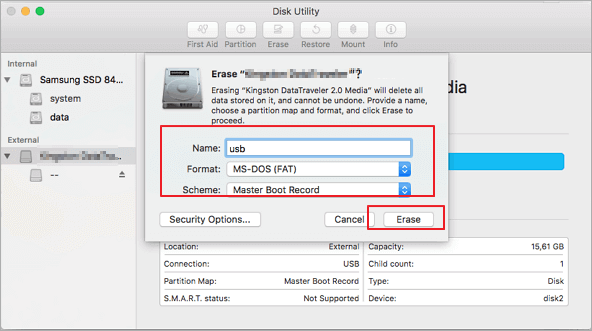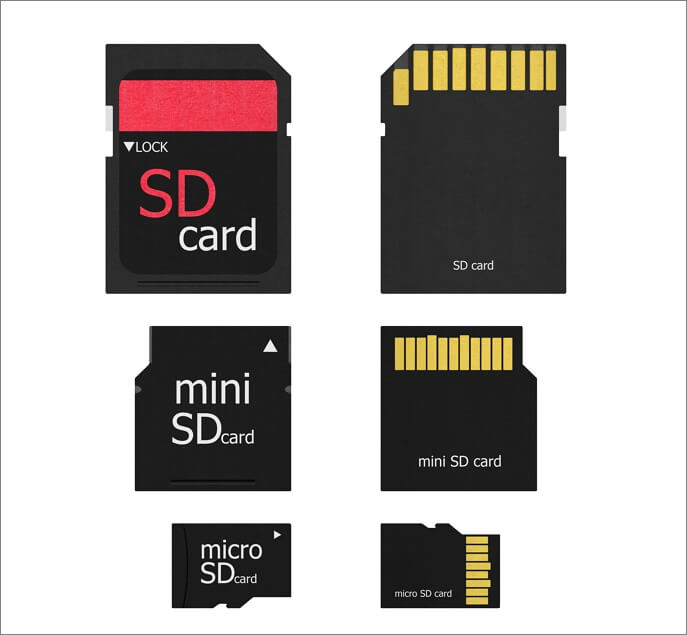Start Your Free Trial!
Sign up to our newsletter, stay updated on news and exclusive offers from EaseUS. Don't worry, if you change your mind, you can unsubscribe at any time, free of charge. We value your privacy (Privacy Policy).
Page Table of Contents
What Is a Mini SD Card HOT
Mini SD Card Adapter/ReaderHOT
How to Format Mini SD Card on Windows 10HOT
How to Format Mini SD Card on MacHOT
Mini SD Card VS Micro SD Card VS SD Card, What Are the DifferencesHOT
Mini SD Card OverviewHOT
About the Author
Hot Topics
Updated on Mar 29, 2025
In this article, you'll learn:
Mini SD card, short for Mini Secure Digital Memory Card, is derived from the SD card, and its performance is not much different from the traditional SD card. Mini SD card, like the SD card, has a data transfer speed of 2MB per second and a hardware data write protection switch, which can avoid the risk of accidental deletion of stored content.

The features of the Mini SD card are:
Like other removable flash memory cards, a Mini SD card can be used on portable devices such as cameras or smartphones to store various types of files, including photos, videos, music, documents, or programs. You can use a Mini SD card in an SD card slot via a card reader. In this way, you can connect your Mini SD card to the computer to transfer files.
The Mini SD card was jointly developed by Panasonic and SanDisk. In order to make it easier for more users to switch between different memory cards and use mini SD, SanDisk also specially introduced an SD card adapter or reader, which can be used with digital cameras, PDAs, and MP3 music players that currently use SD cards.

Mini SD card has the same read-and-write performance and large capacity as an SD memory card. It is fully compatible with standard SD cards and can be used as a normal SD card through the included SD card adapter.
You can easily format a Mini SD card on Windows 10 the following two methods.
To securely format the Mini SD card on Windows 10, you can resort to EaseUS Partition Master - user-friendly and advanced disk management software. This software enables you to efficiently format and set up a Mini SD card with desired file system in simple clicks.
Free download this partition manager and follow the steps below to format the Mini SD card.
Step 1. Find your SD card and right-click the partition you want to format and choose "Format".
Step 2. Set a new partition label, file system (NTFS/FAT32/EXT2/EXT3/EXT4/exFAT), and cluster size to the selected partition, then click "OK".
Step 3. Click "Yes" on the pop-up window to continue.
Step 4. Click the "Execute 1 Task(s)" button on the toolbar, then click "Apply" to start formatting your SD card.
Other Features in EaseUS Partition Master You May Also Like:
Also, check out how to format a Mini SD card with Windows File Explorer.
Step 1. Connect the Mini SD card to your computer with an SD card adapter.
Step 2. Press Win + E keys to open Windows Explorer. Right-click your Mini SD card, and then choose "Format".
Step 3. Specify the file system and set a new label for your Mini SD card. Click "Start" and "OK" to confirm the formatting.

The following steps show how to format a Mini SD card on Mac by using Disk Utility.
Step 1. Connect your Mini SD card to your Mac using a Mini SD card reader.
Step 2. Run Disk Utility on your Mac.
Step 3. Select your Mini SD card. Choose "Erase" and then select "Format".
Step 4. Choose a file system format. If your Mini SD card is 32GB or larger, choose exFAT. If it is 32GB or smaller, choose FAT32.
Step 5. Click "Erase" when a pop-up message occurs.

Is a Mini SD card the same as a Micro SD card? No, Mini SD card and Micro SD card are two types of cards derived from SD memory cards. We will talk about the differences about regular SD card, Mini SD card, and Micro SD card from the following points.

There are three kinds of SD cards, SD card, Mini SD card, and Micro SD card, also called TF card. They are just different in size and compatible with each other.
The Mini SD card is small in size, stable in performance, and relatively common. As a slender multimedia card, the Mini SD card is widely used in the mobile phone market, such as Motorola MPX100, Panasonic X700, BQ S700, and other brands of mobile phone products that support it. At the same time, it can be used as a standard SD card through an expansion card, which is very convenient.
When you get desired Mini SD card and you want to set up the card for specific usage, EaseUS Partition Master is a reliable tool that you can trust and rely on.
If you have more questions on managing and reading Mini SD card, follow the questions and find answers here:
1. How do I access my mini SD card?
2. How can I read my mini SD card without adapter?
3. What is the best format for mini SD card?
How Can We Help You
Oliver is an EaseUS professional writer who dares explore new areas. With a passion for solving tech issues with straightforward guides for common users, Oliver keeps honing his writing craft by developing in-depth solutions for disk and partition management, computer boot-up issues, file transfer, etc.
Cedric Grantham is a senior editor and data recovery specialist of EaseUS. He mainly writes articles and how-to tips about data recovery on PC and Mac. He has handled 10,000+ data recovery cases and is good at data recovery of NTFS, FAT (FAT32 and ExFAT) file systems, and RAID structure reorganization.
It won't hot image your drives or align them, but since it's coupled with a partition manager, it allows you do perform many tasks at once, instead of just cloning drives. You can move partitions around, resize them, defragment, and more, along with the other tools you'd expect from a cloning tool.
Read MoreI love that the changes you make with EaseUS Partition Master Free aren't immediately applied to the disks. It makes it way easier to play out what will happen after you've made all the changes. I also think the overall look and feel of EaseUS Partition Master Free makes whatever you're doing with your computer's partitions easy.
Read MorePartition Master Free can Resize, Move, Merge, Migrate, and Copy disks or partitions; convert to local, change label, defragment, check and explore partition; and much more. A premium upgrade adds free tech support and the ability to resize dynamic volumes.
Read MoreIt won't hot image your drives or align them, but since it's coupled with a partition manager, it allows you do perform many tasks at once, instead of just cloning drives. You can move partitions around, resize them, defragment, and more, along with the other tools you'd expect from a cloning tool.
Read MoreI love that the changes you make with EaseUS Partition Master Free aren't immediately applied to the disks. It makes it way easier to play out what will happen after you've made all the changes. I also think the overall look and feel of EaseUS Partition Master Free makes whatever you're doing with your computer's partitions easy.
Read MoreRelated Articles
Lenovo Laptop Running Slow Windows 11/10 | Speed It Up
![]() Brithny/2025/01/16
Brithny/2025/01/16
Can't Skip Disk Check on Startup Windows 11 | What Should I Do?
![]() Tracy King/2025/01/23
Tracy King/2025/01/23
How to Partition SSD From BIOS [2025 New Guide]
![]() Cici/2025/04/01
Cici/2025/04/01
How to Fix Dell Laptop Running Slow on Windows 10/11
![]() Cici/2025/02/08
Cici/2025/02/08
EaseUS Partition Master

Manage partitions and optimize disks efficiently
Your best companion for disk partitioning, MBR to GPT/GPT to MBR conversion,even OS migration
CHOOSE YOUR REGION
Start Your Free Trial!
Sign up to our newsletter, stay updated on news and exclusive offers from EaseUS. Don't worry, if you change your mind, you can unsubscribe at any time, free of charge. We value your privacy (Privacy Policy).
Start Your Free Trial!
Sign up to our newsletter, stay updated on news and exclusive offers from EaseUS. Don't worry, if you change your mind, you can unsubscribe at any time, free of charge. We value your privacy (Privacy Policy).